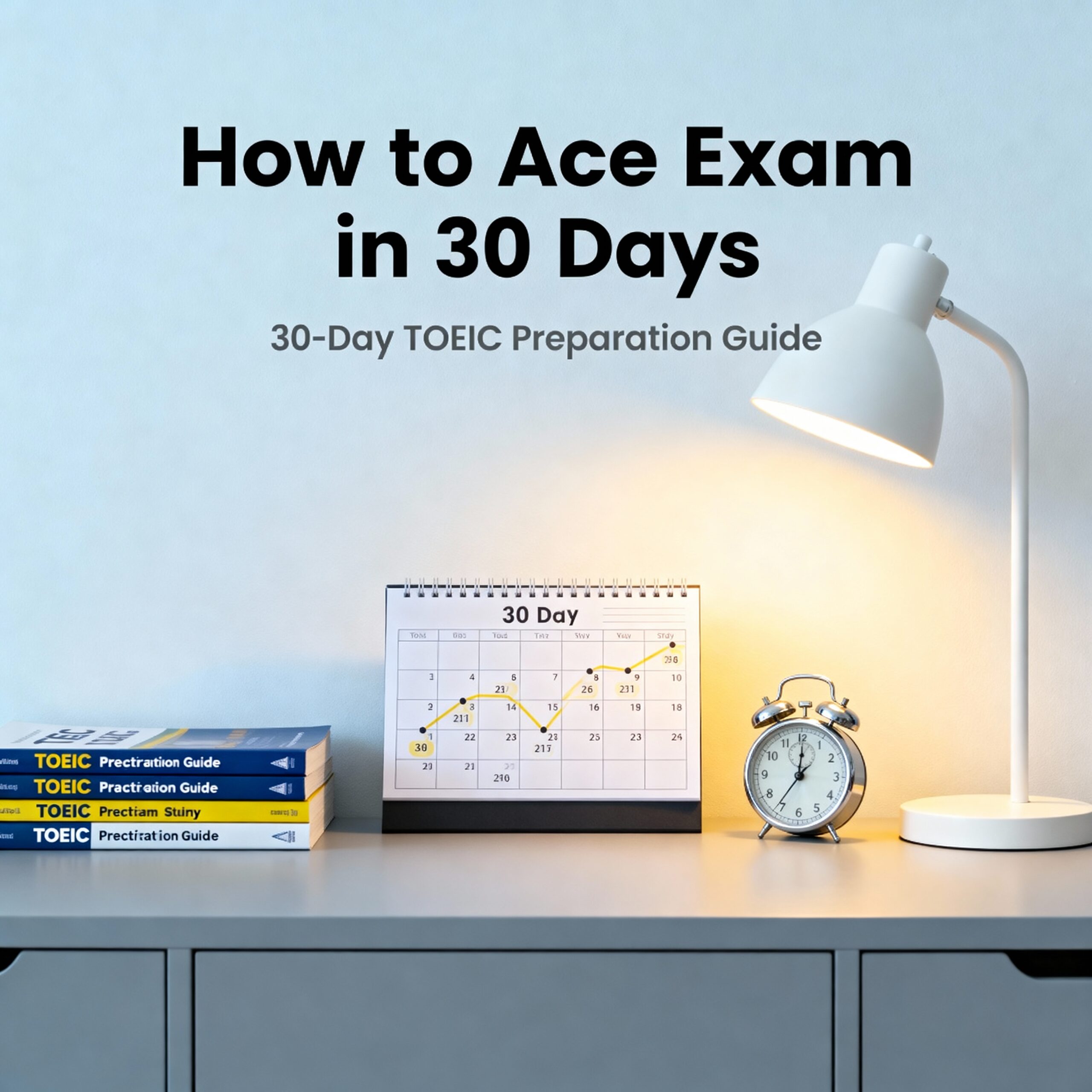TOEIC practice test: How to ace exam in 30 days

Can you really transform your TOEIC score in just one month? Many test-takers believe effective preparation requires several months of study, but with the right strategy and focused practice, 30 days is absolutely enough time to significantly boost your performance. The key isn’t studying longer—it’s studying smarter with targeted TOEIC practice tests and techniques.
Table of Contents
Overview: Your 30-Day TOEIC Success Plan
This 30-day TOEIC preparation plan is designed for busy professionals and students who need to achieve their target score quickly. Whether you’re aiming for job requirements, university applications, or personal goals, this structured approach will help you maximize your score in just one month.
Time requirement: 1-2 hours daily for 30 consecutive days
Difficulty level: Moderate (suitable for those with intermediate English skills)
Expected improvement: 50-150 points (depending on starting level and consistency)
What makes this plan special is its laser focus on high-impact strategies and efficient use of TOEIC practice tests. Rather than covering everything, we’ll concentrate on the patterns and techniques that deliver the biggest score improvements in the shortest time.

Essential Ingredients for TOEIC Success
Study Materials You’ll Need
- Official TOEIC practice tests (at least 2-3 full tests)
- TOEIC preparation book with section-specific strategies
- Vocabulary list of 500-600 common TOEIC words
- Grammar review guide focusing on test-frequent patterns
- Timer or stopwatch for simulating test conditions
- Notebook or digital document for error tracking
- Flashcards (physical or app-based) for vocabulary review
Why Each Component Matters
Official practice tests are crucial because they accurately reflect the actual exam format, question types, and difficulty level. Using unofficial materials might lead to false confidence or unnecessary worry.
Section-specific strategies help you tackle each part of the test efficiently. The TOEIC has predictable patterns, and knowing these shortcuts saves valuable time.
Vocabulary building is essential since the TOEIC frequently tests business and professional terminology. Even strong English speakers can miss points due to unfamiliar vocabulary.
Grammar review focuses your attention on the structures commonly tested in Parts 5 and 6, where quick recognition of patterns leads to easy points.
Timed practice builds the stamina and pacing skills needed for the 2-hour exam. Many test-takers lose points simply by running out of time.
Error tracking helps you identify and fix recurring mistakes, turning weaknesses into strengths.
Substitutions and Variations
- If official TOEIC practice tests are unavailable, high-quality preparation books from reputable publishers can substitute.
- Digital flashcard apps like Anki or Quizlet can replace physical cards for vocabulary study.
- Online TOEIC forums and study groups can supplement individual study for motivation and shared insights.
- Audio materials like podcasts and news broadcasts can enhance listening practice when TOEIC-specific materials are limited.
Step-by-Step 30-Day TOEIC Preparation Plan
Week 1: Assessment and Foundation Building
Day 1-2: Diagnostic and Planning
- Take a full TOEIC practice test under timed conditions
- Score your test and analyze your strengths and weaknesses
- Set a specific target score based on your current level
- Create a daily study schedule for the next 28 days
Day 3-5: Listening Foundations
- Review strategies for each listening section (Parts 1-4)
- Practice 1-2 listening sections daily with careful review
- Start building a list of frequently missed vocabulary
- Learn to predict question types before audio begins
Day 6-7: Reading Foundations
- Learn strategies for Parts 5-7 (grammar, text completion, reading)
- Practice identifying question types quickly
- Review basic grammar patterns tested in Part 5
- Practice skimming and scanning techniques for Part 7
Week 2: Building Core Skills
Day 8-10: Vocabulary Acceleration
- Study 20-30 new TOEIC vocabulary words daily
- Focus on business terms, office vocabulary, and travel words
- Practice using new words in context
- Review previously learned words using spaced repetition
Day 11-14: Grammar Mastery
- Study one key grammar pattern daily (verb tenses, prepositions, etc.)
- Complete 20-30 Part 5 practice questions each day
- Review text completion strategies for Part 6
- Track and review your most common grammar errors
Week 3: Strategy and Speed
Day 15-17: Listening Speed and Accuracy
- Practice Parts 3-4 with pre-reading questions technique
- Work on note-taking skills for longer conversations
- Train your ear to recognize distractors and trap answers
- Practice with various accents and speaking speeds
Day 18-21: Reading Speed and Comprehension
- Time yourself on Part 7 passages (aim for 8-10 minutes per set)
- Practice skimming for main ideas before reading questions
- Learn to identify where to find answers quickly in texts
- Practice eliminating wrong answers when unsure
Week 4: Integration and Test Simulation
Day 22-25: Full Section Practice
- Complete full Listening section (Parts 1-4) under timed conditions
- Complete full Reading section (Parts 5-7) under timed conditions
- Review all mistakes and identify any remaining weak areas
- Focus intensively on your weakest question types
Day 26-28: Full Test Simulation
- Take a complete TOEIC practice test under exact test conditions
- Review your performance and compare to your diagnostic test
- Make final adjustments to your test-taking strategy
- Create a one-page summary of key reminders for each section
Day 29-30: Final Review and Rest
- Lightly review your error patterns and key strategies
- Go through your vocabulary flashcards one final time
- Mentally rehearse your test-day plan and timing strategy
- Relax and get a good night’s sleep before the exam
Assembly: Putting Your TOEIC Skills Together

Combining Section Strategies Effectively
The TOEIC exam tests listening and reading as separate sections, but your preparation should integrate them for maximum effectiveness:
- Connect vocabulary across sections – Words you learn for reading will help in listening, and vice versa
- Apply time management consistently – Develop a rhythm of working efficiently through questions
- Transfer prediction skills – The prediction techniques that work in listening also apply to reading
Test-Day Execution Tips
- Arrive early to reduce stress and familiarize yourself with the testing environment
- Bring necessary items (ID, admission ticket, pencils, eraser, watch)
- Skip difficult questions and return to them if time permits
- Guess strategically on unknown answers rather than leaving them blank
- Maintain awareness of time throughout each section
- Stay calm and focused even if you encounter difficult questions
Storage and Make-Ahead Tips for TOEIC Preparation
Storing Your TOEIC Knowledge Effectively
- Create a digital or physical “error bank” of questions you’ve missed for regular review
- Organize vocabulary by themes (business, travel, technology) for easier recall
- Record key strategies on index cards for quick reference during final review
- Keep a “progress journal” to track improvements and maintain motivation
Preparing in Advance for Best Results
- Pre-mark your practice tests with time checkpoints (e.g., “25 minutes – should be at question 30”)
- Pre-record audio summaries of key strategies to listen to during commutes
- Prepare healthy snacks and water for study sessions to maintain energy
- Set up a distraction-free study environment before beginning each session
TOEIC Preparation Variations
For Different Starting Levels
Beginners (below 500)
- Focus more time on basic grammar and vocabulary
- Use simplified practice materials before official tests
- Spend extra time on listening comprehension fundamentals
Intermediate (500-700)
- Balance time equally between all sections
- Focus on eliminating careless errors
- Work on increasing reading and listening speed
Advanced (700+)
- Focus on the most difficult question types
- Practice with more challenging materials
- Fine-tune timing strategies to maximize score
For Different Learning Styles
Visual learners
- Use charts and diagrams to organize grammar rules
- Color-code your notes by section or question type
- Watch video explanations of test strategies
Auditory learners
- Record yourself reading vocabulary and definitions
- Discuss strategies and explanations out loud
- Use more listening practice beyond official materials
Kinesthetic learners
- Walk while reviewing flashcards
- Use physical movements to remember grammar patterns
- Take frequent short breaks during study sessions
Conclusion: Your TOEIC Success Awaits

With this 30-day plan and consistent TOEIC practice tests, you’re well-equipped to achieve significant improvement in your score. Remember that success comes from smart, targeted preparation rather than endless hours of unfocused study.
The most important factors are consistency (studying daily), strategic focus (concentrating on your weak areas), and realistic practice (using official-style materials under timed conditions).
Don’t be discouraged by difficult questions or practice tests—each mistake is an opportunity to learn and improve. By identifying and fixing your error patterns, you transform weaknesses into strengths.
As your test date approaches, trust in your preparation. You’ve put in the work with quality TOEIC practice tests and targeted study. Now it’s time to demonstrate your skills and achieve the score you deserve.
Frequently Asked Questions
Q: Is 30 days really enough to prepare for the TOEIC?
A: Yes, with focused study and quality TOEIC practice tests, 30 days is sufficient to significantly improve your score, especially if you already have intermediate English skills.
Q: How many hours should I study each day?
A: Aim for 1-2 hours of focused study daily. Quality matters more than quantity—concentrated, error-analyzing practice beats passive reviewing.
Q: Which is more important: vocabulary or grammar?
A: Both are essential, but vocabulary typically yields faster improvements, especially for intermediate learners. Grammar becomes more important for scores above 700.
Q: Should I guess if I don’t know an answer?
A: Yes, always. The TOEIC has no penalty for wrong answers, so never leave a question blank.
Q: How many practice tests should I take?
A: At minimum, take a diagnostic test at the beginning and a full practice test in the final week. Ideally, complete 3-4 full practice tests spread throughout your preparation.
Q: What’s the best way to improve listening skills quickly?
A: Practice with official TOEIC listening materials daily, focusing on prediction skills and identifying key information. Supplement with English podcasts and news.
Q: How can I avoid running out of time on the reading section?
A: Practice timed reading regularly, learn to skim effectively, and develop a strategy for difficult questions (mark and return if time permits).
Q: What should I do the day before the test?
A: Light review only—no intensive studying. Gather your test materials, plan your route to the test center, and get a good night’s sleep.
Q: Can I use my phone during breaks in the TOEIC exam?
A: No, electronic devices are not permitted during the test, including during breaks. Plan accordingly.
Q: How soon can I retake the TOEIC if I don’t reach my target score?
A: You can take the TOEIC as often as it’s offered, but consider allowing at least 2-4 weeks for additional preparation if you need to retake it.






